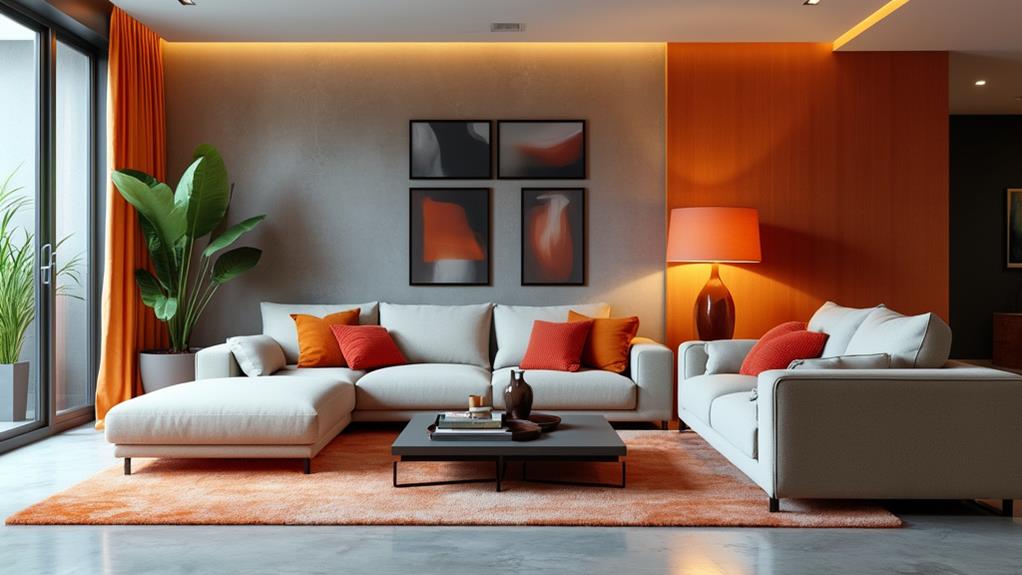Subscription furniture is revolutionizing home decor by enhancing flexibility, ensuring sustainability, and reducing upfront costs. Moving away from traditional ownership, consumers now prioritize experience and adaptability, which aligns with the circular economy's principles of reuse and recycling. This model allows for stylish experimentation with diverse design themes without a long-term commitment, catering to transient lifestyles and evolving aesthetic preferences. Additionally, subscription services democratize access to premium furniture, reflecting personalization and customization demands. However, challenges such as potential damage fees and limited style availability persist. As social media continues to influence design trends, the implications broaden considerably.
Table of Contents
ToggleShifting Consumer Preferences
In today's rapidly evolving consumer landscape, many are gravitating away from traditional ownership models towards experience-focused consumption. This shift is particularly evident in the domain of home decor, where consumers now prioritize flexibility and convenience over permanent ownership.
The trend is driven by transient living situations and a desire for evolving aesthetic trends. Additionally, sustainability and resource-consciousness have become central to consumer choices, aligning with a cultural shift that values experiences over material possessions.
There is a growing demand for customizable and personalized furniture options, reflecting a minimalist and decluttered lifestyle. Young consumers, influenced by social media and cost considerations, are more inclined to embrace rental services, seeking trendy, high-quality pieces that do not demand high costs.
Flexible Home Design Solutions
Flexibility in home design emerges as a cornerstone for modern living, reshaping how spaces are tailored to reflect current trends and individual preferences.
Subscription furniture services offer innovative solutions, enabling homeowners to adapt their environments effortlessly. By allowing consumers to experiment with various styles and themes without significant financial commitment, these services encourage dynamic interior design. Monthly payment options enhance financial flexibility, aligning with the shift from ownership to experience-focused consumption.
This model democratizes access to high-end design, making it feasible for a broader audience. Additionally, smart solutions cater to compact urban living, optimizing space while maintaining aesthetic appeal.
Ultimately, subscription models facilitate personal expression and trend awareness, ensuring homes remain both economically viable and visually harmonious.
Environmental Advantages
As modern living spaces evolve to accommodate shifting consumer preferences, the environmental benefits of subscription furniture become increasingly apparent.
This innovative model supports a circular economy by promoting the reuse and recycling of furniture, considerably reducing waste. By opting for subscription services, consumers contribute to minimizing the ecological footprint associated with traditional furniture production, which often involves resource-intensive processes.
Subscription furniture encourages manufacturers to prioritize quality and sustainability, leading to the creation of more durable products. This approach not only reduces landfill waste from discarded items but also supports eco-friendly practices through rental and reuse.
Ultimately, this model aligns with a growing emphasis on sustainability, providing environmentally conscious consumers a practical solution for reducing their impact on the planet.
Economic Impacts and Trends
Although subscription furniture models are transforming consumer behavior, they also present notable economic impacts and trends worth considering. The shift towards subscription-based furniture arrangements has several economic implications.
To begin with, it reduces the upfront financial burden on consumers, allowing them to distribute costs over time. Additionally, it fosters increased spending on home decor and accessories due to the flexibility in budget allocation.
Thirdly, the furniture rental market is anticipated to witness considerable growth by 2025, driven by the rising demand for sustainable consumption patterns.
- Lower Upfront Costs: Consumers benefit from manageable monthly payments instead of large one-time expenses.
- Increased Spending: Flexibility in budgeting encourages additional expenditures on decor.
- Market Growth: The furniture rental industry is projected to expand considerably by 2025.
Subscription Model Challenges
The economic advantages of subscription furniture models are evident, but they are not without their challenges. One primary concern is the potential for damage or wear on rented items, which can lead to additional fees for consumers.
Moreover, the availability of certain styles or brands may be limited, restricting consumer choice and satisfaction. Clear rental agreements are essential, yet often complex, requiring thorough consumer education to understand long-term costs versus traditional ownership.
Additionally, subscription services face competition from well-established furniture retailers and e-commerce platforms, which may offer more diverse selections. As subscription models attempt to balance flexibility and cost-effectiveness, they must also navigate these challenges to maintain consumer trust and effectively compete in a rapidly evolving market.
Social Media Influence
Social media platforms have become pivotal in shaping consumer tastes and preferences, particularly in the domain of home decor. As users scroll through their feeds, they are constantly exposed to innovative furnishing ideas and styles. This visual engagement leads to a heightened interest in subscription furniture models.
Social media's role in home decor can be categorized into several key areas:
- Trendsetters: Influencers and designers showcase cutting-edge home decor trends, encouraging followers to explore subscription options.
- Community Engagement: Platforms facilitate conversations around decor preferences, allowing users to share experiences with subscription services.
- Visual Inspiration: A plethora of images and videos offer endless design possibilities, enticing consumers to experiment with rental furniture.
These elements collectively drive the demand for flexible, affordable, and trendy home furnishings.
Customization and Personalization
Furniture subscription models offer a unique opportunity for customization and personalization, allowing consumers to tailor their living spaces to reflect their individual tastes and lifestyles.
This approach caters to shifting consumer preferences, where flexibility and adaptability are paramount. By leveraging subscription services, users can experiment with diverse design themes and styles without the long-term commitment of ownership.
Tailored selections enable consumers to align their home decor with current trends, creating spaces that resonate personally and aesthetically.
Additionally, this model supports a culture of minimalism and decluttering, encouraging the use of high-quality, trendy pieces on a rotational basis.
Subscription services democratize access to premium furniture, offering personalized choices at manageable costs, thereby enhancing the consumer's ability to curate an evolving home environment.


